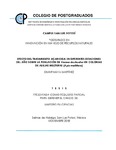| dc.contributor.advisor | Medina Flores, Carlos Aurelio | es_MX |
| dc.contributor.advisor | López Carlos, Marco Antonio | es_MX |
| dc.contributor.author | Maya Martínez, Omar | |
| dc.creator | MAYA MARTINEZ, OMAR; 617444 | |
| dc.date.accessioned | 2019-03-09T20:54:00Z | |
| dc.date.accessioned | 2019-03 | |
| dc.date.available | 2019-03-09T20:54:00Z | |
| dc.date.available | 2019-03 | |
| dc.date.issued | 2018-12 | |
| dc.date.submitted | 2018-12 | |
| dc.identifier.citation | Maya Martínez, Omar (2018) Efecto del tratamiento acaricida en diferentes estaciones del año sobre la población de Varroa destructor en colonias de abejas melíferas (Apis mellifera). Salinas de Hidalgo, S. L. P.: El autor, Tesis (Maestría en Ciencias, especialista en Innovación en el Manejo de Recursos Naturales), Colegio de Postgraduados, Campus San Luis Potosí, 2018 | es_MX |
| dc.identifier.uri | http://hdl.handle.net/10521/3132 | |
| dc.description.abstract | El objetivo del presente trabajo fue determinar el efecto del tratamiento a base de amitraz aplicado en diferentes estaciones del año sobre los niveles de infestación por Varroa destructor y las condiciones poblacionales y alimenticias de colonias de abejas melíferas. Se utilizaron 48 colonias con valores homogéneos de población de abejas, cría, reservas de alimento, niveles de infestación por varroa en abejas y origen y edad de las reinas. 12 colonias recibieron tratamiento acaricida en el verano, 12 en el invierno, 12 en verano e invierno y 12 no recibieron tratamiento. Durante un año se evaluaron los niveles de infestación por varroa en abejas adultas, cría y en piso adherible de las colmenas (caída de ácaro) así como la población de abejas en área, áreas de cría operculada, reservas de alimento y peso de las colonias. Los resultados muestran que dos aplicaciones en diferentes estaciones del año es mejor que una. Así mismo se observó que las colonias tratadas en invierno y en verano e invierno tuvieron niveles de infestación por varroa en abejas adultas significativamente (p =0.004) inferiores a las colonias tratadas en el verano y no tratadas. Se observó correlación positiva y significativa entre el nivel de infestación en abejas adultas con el nivel de infestación en cría (r =0.52, p <0.001) y con la mortalidad de varroa (r =0.63, p <0.001); y una correlación negativa entre el nivel de varroa en abejas adultas con las áreas de miel (r =-0.32, p <0.05). El resultado obtenido permite concluir que la efectividad de las aplicaciones de amitraz para el control de varroa dependió de las estaciones de año, lo que implica reconocer que hay un efecto ambiental que debería estudiarse con mayor detalle. | es_MX |
| dc.description.abstract | The aim of this study was to determine the effect of the treatment based of amitraz applied in different seasons of the year on the levels of infestation by Varroa destructor and the population and food conditions of honey bee colonies. 48 colonies were used with homogeneous values of bee population, brood, food reserves, levels of varroa infestation in bees and origin and age of the queens. 12 colonies received acaricidal treatment in summer, 12 in winter, 12 in summer and winter and 12 did not receive treatment. During one year the levels of varroa infestation were evaluated in adult bees, worker brood and in the adherable floor of the hives (fall of mite) as well as the population of bees, operculated brood areas, food reserves and weight of the colonies. The results show that two applications in different seasons of the year is better than one. Likewise, it was observed that the colonies treated in winter and summer and winter had significantly higher levels of varroa infestation in adult bees (p = 0.004) than the colonies treated in the summer and not treated. A positive and significant correlation was observed between the level of infestation in adult bees with the infestation level in worker brood (r = 0.52, p <0.001) and with varroa mortality (r = 0.63, p <0.001); and a negative correlation between varroa level in adult bees and honey areas (r = -0.32, p <0.05). The result obtained allows us to conclude that the effectiveness of applications of amitraz for the control of varroa depended on the seasons of the year, which implies recognizing that there is an environmental effect that should be studied in greater detail. | es_MX |
| dc.description.sponsorship | Conacyt | es_MX |
| dc.format | pdf | es_MX |
| dc.format.extent | 2.4 Mb | |
| dc.language.iso | spa | es_MX |
| dc.publisher | El autor | es_MX |
| dc.rights | Acceso abierto | es_MX |
| dc.rights.uri | http://creativecommons.org/licenses/by-nc-nd/4.0 | es_MX |
| dc.subject | Research Subject Categories::VETERINARY MEDICINE::Pharmacological research | es_MX |
| dc.subject.classification | CIENCIAS AGROPECUARIAS Y BIOTECNOLOGÍA::CIENCIAS AGRARIAS::PRODUCCIÓN ANIMAL::APICULTURA | es_MX |
| dc.subject.other | Maestría | es_MX |
| dc.subject.other | IMRN | es_MX |
| dc.subject.other | Abeja melífera | es_MX |
| dc.subject.other | Honey bees | en |
| dc.subject.other | Varroasis | es_MX |
| dc.subject.other | Enfermedades parasitarias | es_MX |
| dc.subject.other | Parasitoses | en |
| dc.subject.other | Varroa destructor | |
| dc.subject.other | Amitraz | |
| dc.subject.other | Acaricidas | es_MX |
| dc.subject.other | Acaricides | en |
| dc.subject.other | Apis mellifera | |
| dc.title | Efecto del tratamiento acaricida en diferentes estaciones del año sobre la población de Varroa destructor en colonias de abejas melíferas (Apis mellifera). | es_MX |
| dc.title.alternative | Effect of acaricide treatment in different seasons of the year on the population on Varroa destructor in honey bee colonies (Apis mellifera). | es_MX |
| dc.type | Tesis | es_MX |
| dc.type.conacyt | masterThesis | es_MX |
| dc.identificator | 6||31||3104||310401 | es_MX |
| dc.contributor.director | AQUINO PEREZ, GILDARDO; 35044 | |
| dc.contributor.director | OLMOS OROPEZA, GENARO; 215581 | |
| dc.audience | generalPublic | es_MX |


